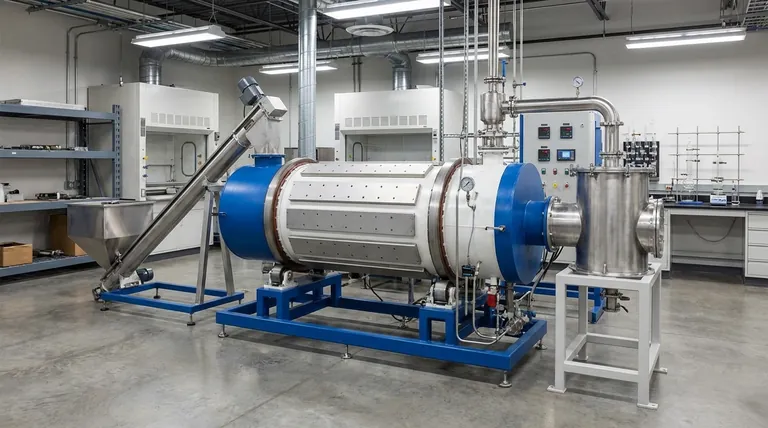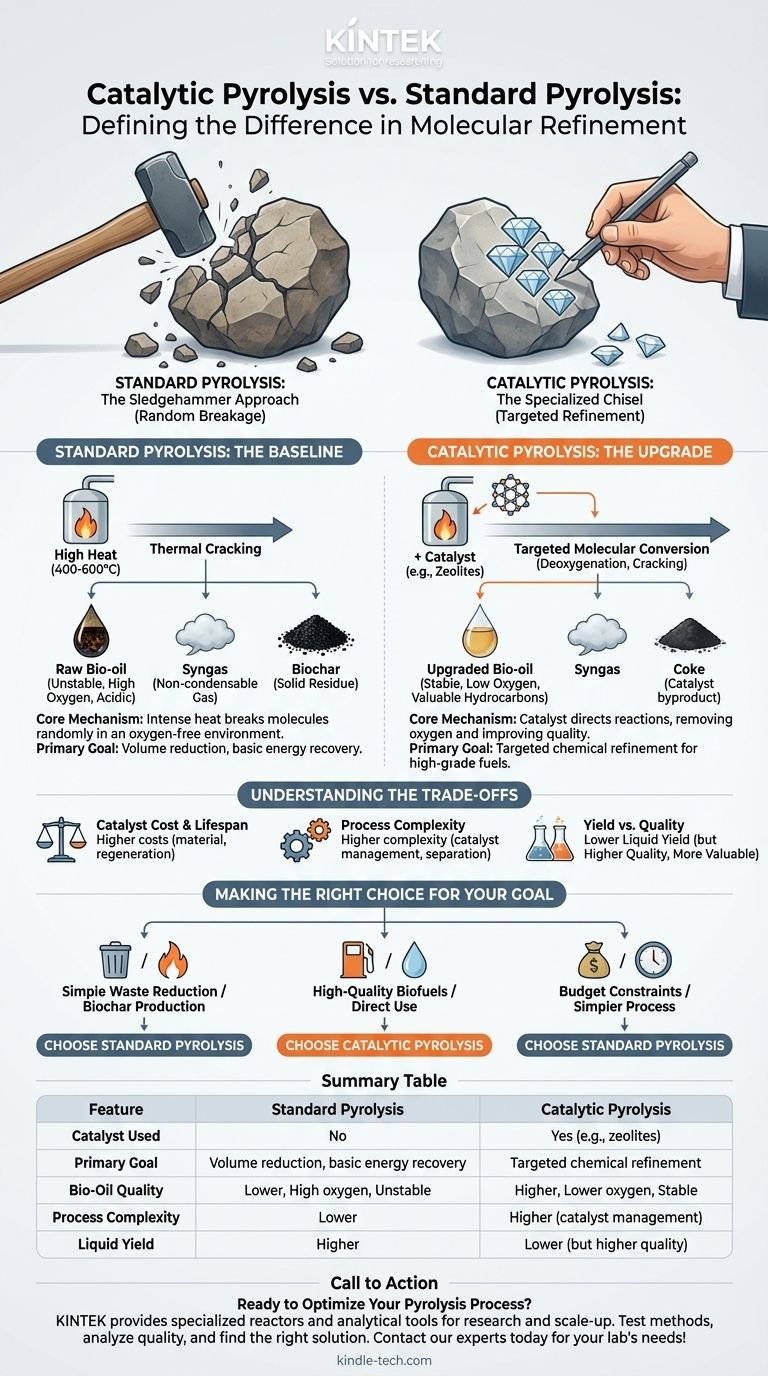The fundamental difference is the use of a catalyst. Standard pyrolysis uses high heat in an oxygen-free environment to thermally decompose materials like biomass or plastic. Catalytic pyrolysis introduces a catalyst into this process to actively direct the chemical reactions, improving the quality and composition of the final products.
Think of it this way: standard pyrolysis is like using a sledgehammer to break a large rock into smaller, random pieces. Catalytic pyrolysis is like using a specialized chisel to break that same rock into specific, more valuable shapes.

Understanding Standard Pyrolysis: The Baseline
Standard pyrolysis is a foundational thermochemical conversion process. It relies on a single input—heat—to achieve decomposition.
The Core Mechanism
In this process, feedstock is heated to high temperatures (typically 400-600°C) in a reactor without oxygen. This intense heat breaks the complex, long-chain molecules of the material into smaller, simpler molecules.
The process is a form of thermal cracking, driven entirely by temperature and reaction time.
The Typical Output
The output is a mixture of three primary products:
- Bio-oil (or pyrolysis oil): A liquid with a complex chemical composition, often acidic, unstable, and high in oxygen content. It typically requires significant upgrading before it can be used as a fuel.
- Syngas: A non-condensable gas mixture.
- Biochar: A solid, carbon-rich residue.
The primary goal is often simple volume reduction or basic energy recovery, not the production of high-grade fuels.
Introducing Catalytic Pyrolysis: The Upgrade
Catalytic pyrolysis refines the standard process by adding a layer of chemical intelligence. The goal shifts from mere decomposition to targeted molecular conversion.
The Role of the Catalyst
A catalyst lowers the energy required for specific chemical reactions to occur. In pyrolysis, it selectively promotes reactions that remove oxygen (deoxygenation) and crack heavy molecules into more desirable compounds, such as aromatic hydrocarbons.
This results in a final product that is more stable and has a higher energy density.
The Impact on Bio-Oil Quality
The presence of a catalyst fundamentally changes the output. The resulting bio-oil has a significantly improved quality:
- Lower oxygen content
- Lower acidity
- Higher chemical stability
- Increased concentration of valuable hydrocarbons
This upgraded liquid is much closer to conventional fossil fuels and requires less post-processing.
Common Implementation Methods
There are two primary strategies for introducing the catalyst, each with different engineering considerations:
- In-situ: The catalyst is mixed directly with the feedstock inside the primary pyrolysis reactor (e.g., a fluidized-bed or rotary kiln).
- Ex-situ: The pyrolysis vapors first leave the initial reactor and then pass through a separate, secondary reactor that contains only the catalyst bed.
Understanding the Trade-offs
Choosing to use a catalyst introduces significant benefits but also comes with clear operational and economic challenges.
Catalyst Cost and Lifespan
High-performance catalysts, such as zeolites, can be expensive. Furthermore, they deactivate over time as their surfaces become coated with coke (a carbon byproduct) or are poisoned by contaminants in the feedstock.
This requires either periodic replacement or a regeneration process, adding to both capital and operational costs.
Process Complexity
Managing a catalyst adds a layer of complexity. The in-situ method requires effective separation of the catalyst from the biochar after the reaction. The ex-situ method requires an entirely separate reactor vessel and associated systems.
Yield vs. Quality
Catalytic pyrolysis often produces more gas and coke at the expense of the total liquid yield. You may get less bio-oil overall, but the quality of that liquid is substantially higher and more valuable. This is a critical trade-off between quantity and quality.
Making the Right Choice for Your Goal
The decision to use a catalyst depends entirely on your desired end product and operational capabilities.
- If your primary focus is simple waste reduction or producing biochar: Standard pyrolysis offers a less complex and lower-cost solution that effectively achieves these goals.
- If your primary focus is producing high-quality liquid biofuels for direct use or easier refining: Catalytic pyrolysis is essential to create a more stable, energy-dense product without extensive post-processing.
- If you are constrained by budget or require a simpler process: The added cost and complexity of catalyst management may make standard pyrolysis the more practical choice.
Ultimately, your choice hinges on whether your objective is simple decomposition or targeted chemical refinement.
Summary Table:
| Feature | Standard Pyrolysis | Catalytic Pyrolysis |
|---|---|---|
| Catalyst Used | No | Yes (e.g., zeolites) |
| Primary Goal | Volume reduction, basic energy recovery | Targeted chemical refinement for high-grade fuels |
| Bio-Oil Quality | Lower quality, high oxygen, unstable | Higher quality, lower oxygen, more stable |
| Process Complexity | Lower | Higher (catalyst management required) |
| Liquid Yield | Higher | Lower (but higher quality) |
Ready to Optimize Your Pyrolysis Process?
Whether your goal is simple waste reduction with standard pyrolysis or producing high-value biofuels with catalytic pyrolysis, KINTEK has the laboratory equipment and expertise to support your research and development. Our specialized reactors, temperature control systems, and analytical tools are designed to help you achieve precise, reliable results.
We help you:
- Test and compare pyrolysis methods efficiently.
- Scale up your process from lab to pilot.
- Analyze product quality with precision.
Let's discuss your specific application. Contact our experts today to find the right solution for your lab's needs!
Visual Guide

Related Products
- Electric Rotary Kiln Small Rotary Furnace Biomass Pyrolysis Plant
- Customizable High Pressure Reactors for Advanced Scientific and Industrial Applications
- Mini SS High Pressure Autoclave Reactor for Laboratory Use
- High Pressure Laboratory Autoclave Reactor for Hydrothermal Synthesis
- Stainless High Pressure Autoclave Reactor Laboratory Pressure Reactor
People Also Ask
- What are the different types of pyrolysis machines? Choose the Right System for Your Output
- How is energy converted into biomass? Harnessing Nature's Solar Power for Renewable Energy
- Is pyrolysis viable? A Guide to Economic, Technological, and Environmental Success
- What are the components of biomass pyrolysis? A Complete Guide to the System, Products, and Process
- What is a disadvantage of biomass energy? The Hidden Environmental and Economic Costs



















